Photo Quiz #2 Answer
By Jim Burns
A) Good photo, easy bird
Difficult to find? Yes. Difficult to see this well? Yes. Difficult to identify if you have this good of a look? No! The tall, slender build of this bird and the long bill with both mandibles decurved quickly places it in the thrasher family....but which of our five desert thrashers is it? If you're using the first edition of the National Geographic guide, you should know that the desert thrasher page is perhaps the only really bad page in the book. The desert thrashers are shades of warm browns, not the cold grays shown in the guide, and the eye of the Crissal is light as the text says, not dark as in the plate.
Only one Arizona thrasher shows a dark eye and this noticeable contrast between back and tail color as seen by our quiz bird. This LeConte's Thrasher was photographed March 1997, at the Salome Highway thrasher site. January and February are the best months to visit this site as the thrashers will tee up and sing in the early morning cool of their nesting season. It is possible to score four species on one visit, two in the same mesquite, making for fascinating comparisons.
LeConte's upper parts will match the ground color in these Saltbush flats, and the crissum (undertail coverts) will be a richer, brighter version of the same color - manila to almost peach at times. At a distances, the tail will often appear black in contrast with the sandy ground color. LeConte's feeds like the Sage Sparrows, which share its territory in winter, scampering on the ground from bush to bush with its tail cocked up.
The Sage Thrasher is short, stocky, and more common as a March migrant moving north; the Bendire's is taller and slimmer, but still smallish; the LeConte's is a big thrasher, but noticeably more slender and "dainty" when seen together with the heavier, chestier Crissal. Differences in bill size and length correlate nicely. Curve-billed Thrasher does not normally occur at this site, despite out-of-state birders' reports to the contrary.
B) Good photo, difficult bird
This species never seems to appear as expected, unexpectedly giving many people trouble, perhaps because it is infrequently seen, perhaps because it looks a little like a lot of other species. It shows a short bill, a pale eye, plain, unstreaked upperparts with a thin, white wingbar, and heavy spotting on the underparts. It could be passed off as a Cactus Wren, a juvenile Northern Mockingbird, or one of the thrushes.
Cactus Wren would have spots and streaking on the upperparts and a broad, white supercillium; a juvenile mocker would show a much larger white wing patch; thrushes, along with their extensive spotting, would show a dark eye. No, this is another thrasher - but which one is it?
Bendire's has a short bill with a decurved upper mandible....but Bendire's bill isn't this stubby or this thick. Bendire's has well-defined spots on the underparts....but Bendire's spotting is not nearly this prominent or this extensive. Bendire's would show this bird's moustachial marking and light iris, but not this bird's white wingbar. This Sage Thrasher, smaller and stockier, and a darker shade of brown than a Bendire's, was photographed March 1997, at the Salome Highway thrasher spot.
C) Bad photo, easy bird
Now you're jumping to conclusions. You think: this guy is another thrasher. You're thinking: here's the Bendire's disguised in a bad photo. The bill looks decurved and the bill/head proportions look about right. Wrong! Go back and re-read your clue - Bendire's is an Arizona resident and we're dealing here with a post-breeding visitor. Besides, you should know I'm very frugal. I wouldn't burn film on a bad photo of a bird that will tee up in the morning sun.
What's wrong with this photo? Well, the focus is not real sharp, and if you look at the leaves and branches you'll realize that it is grossly overexposed. A reasonably competent photographer would do this only for a record of a rare bird lurking behind three feet of shadowed foliage. Overexposure has blown out most of the foliage, leaving only a silhouette profile....and two clues.
Look quickly, then look away. There is a familiar looking posture/jizz to this bird. It says "robin", or at least "thrush family". Now look carefully at the tip of the tail, the uppertail coverts and the tertial edgings of the folded wing. These areas are not like the hotspots of light on the crown and back. They are areas of white, popped from the shadows by darkroom tweaking, yet the dark areas still look very dark despite all the exposure.
This is a dark thrush with extensive white areas, upper and rear. This Aztec Thrush was part of the remarkable invasion which took place in early fall, 1996. It is an adult male, photographed in Miller Canyon in the Huachuca Mountains. When you see this beautiful chocolate/white bird in the open you'll not mistake it for any other bird.



